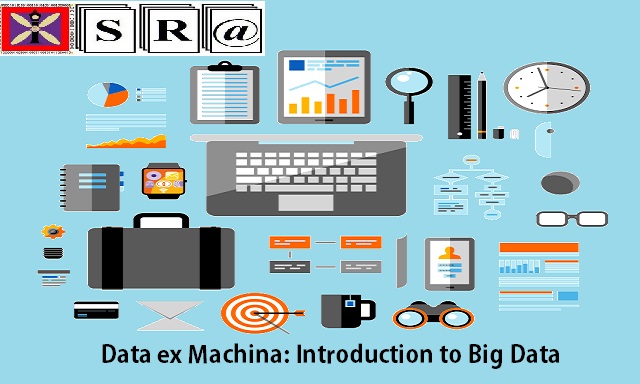Abstract
Social life increasingly occurs in digital environments and continues to be mediated by digital systems. Big data represents the data being generated by the digitization of social life, which we break down into three domains: digital life, digital traces, and digitalized life. We argue that there is enormous potential in using big data to study a variety of phenomena that remain difficult to observe. However, some recurring vulnerabilities should be addressed. We also outline the role institutions must play in clarifying the ethical rules of the road. Finally, we conclude by pointing to several nascent but important trends in the use of big data.
Keywords
big data, computational social science, technology, research methodology, quantitative sociology, research ethics, research design, social media, CDR data, data linkage, networks, mobility
INTRODUCTION
Archives of human activity go back millennia; however, the increasingly comprehensive digital archives of human behavior, combined with the exponential growth of computational power, create the potential for a transformation of fields such as sociology. Core constructs of sociology, such as interaction, collective action, expression, and diffusion of behavior lurk in these archives. It is possible to study the connectivity of entire human societies, including who communicates with whom about what, how people move through space, who says what, and who buys what, all with a temporal granularity of seconds. The coming generation will witness a transformation of sociological theory through these improvements in our ability to observe dynamic social systems (Boyd & Crawford 2012, Golder & Macy 2014).
Big data does pose distinctive challenges for scholars. These digital archives are not the product of scientific design. The information captured in these archives is not what a social scientist would choose. Further, what is captured is constantly, and sometimes abruptly, changing. The signal in big data is vulnerable to manipulation, sometimes purposive, sometimes incidental. Further, relevant behaviors are split into many archives, with no practical way of conjoining them. For example, there may not be a strong conceptual or empirical distinction or boundary to be drawn between behaviors captured by different cell phone carriers, but most research on cell phone data is based on data from a single carrier.
Big data also presents enormous institutional challenges to sociology. The large majority of sociologically relevant analysis of big data is done by computer scientists, and there is a relatively little reflection of the big data revolution in top sociology journals. Only 6 of 182 articles published between 2012 and 2016 in the American Journal of Sociology (AJS) and 9 of 240 in American Sociological Review (ASR) involve the use of big data.1
The objective of this review, therefore, is to critically assess the potential of big data for the collective intellectual endeavor that is sociology. In what follows, we provide a brief overview of what big data is and then review recent big data projects. We break these projects down into three types of big data, enumerate the promises and pitfalls common across them, and offer guidance to sociology for moving forward. We conclude by drawing together the challenges that remain across all three areas and outline the work that needs to be done to put the field on the more solid ethical, methodological, and epistemic ground. We hope to demonstrate the value of big data research while articulating its most pressing problems and offering reasonable strategies for advancing the field.
FUTURE TRENDS
Researchers have used big data to answer old questions in new ways and new questions never before answerable. Their successes and failures have helped us identify the promises and pitfalls of research in this area and the kinds of investment institutions need to make for the future of this research. In this final section, we point to six trends that will likely affect the big data landscape in hopes of helping sociology get ahead of the curve.
Introduction to Big Data -More Data Are Coming
Big data will continue to grow into more domains. For example, EventRegistry provides data on events, and it also acts as a repository providing real-time access to more than 100,000 news publishers (http://www.EventRegistry.org). Big data will also continue to reach back into the past as libraries digitize their collections, newspapers digitize their archives, and initiatives such as Google Books and Project Gutenberg digitize books. The question for data coverage will continue to be less about whether the data exist, but more about what can be studied with the available data.
More linkages between different big data will become more common. The work of Chetty and colleagues (2014a,b, 2016) with IRS data is only the beginning. Another opportunity is connecting online data to offline data, such as linking social media accounts to voter records and data collected by brokers such as Acxiom. One revolutionary form of big data linkage is wikification, which involves linking words and phrases in the text to entities in Wikipedia (Mihalcea & Csomai 2007). Entity linkage allows researchers to use the structured and unstructured data Wikipedia maintains on entities to enhance the contextual information associated with texts.
Introduction to Big Data – Different Data Are Coming
The majority of data being created on big data platforms are still unusable for social scientific research. These are the images, audio, and video is created, discussed, and shared. The tools for providing meaningful structure to these data at scale have lagged behind those of other types of data, such as text. They are quickly catching up. For example, image processing using convolutional neural nets and other deep learning methods has become as easy to use in Python and R as methods for text analysis. Furthermore, the tools to analyze these data are increasingly being made available through publicly accessible interfaces like Google Cloud Vision API. With publicly accessible models, researchers upload their files to the service, which uses pre-trained models to make inferences about the file and then sends these inferences back as metadata.
Introduction to Big Data – Models Will Become More Generic
Google Cloud Vision API is a prime example of another critical trend in machine learning: creating generic models and making them available to the public. There is a long precedent for creating and sharing models for processing unstructured data. The Linguistic Inquiry and Word Count dictionary are perhaps the best known in the social sciences (Tausczik & Pennebaker 2010). However, such models are now being published in a variety of methods. For example, Jozefowicz et al. (2016) trained a deep learning model on the One Billion Word Benchmark and are publishing the model itself as an alternative to the model released in 2014 in Stanford’s GloVe (Pennington et al. 2014). Like the Vision API, researchers can use these models on their texts to generate word embeddings.
Generic models allow researchers to use pre-trained machine learning models on their data, rather than having to deal with the issues of data processing and model specification. These out-of-the-box machine learning projects aspire to use big data to create the most effective models and then make those models the standard for processing unstructured data. However, generic models are not necessarily better at applied tasks than specialized models. And, in the absence of a social theory, such generic models may miss obvious social patterns in data, potentially reinforcing long-standing social biases (Caliskan et al. 2017).
Introduction to Big Data – Data from Multiple Platforms Will Become Standard
As big data systems proliferate and multiple systems offer similar services, it will become increasingly possible and easier for researchers to perform studies on different platforms. The CrowdBerkeley project is offering data for multiple crowdfunding websites such as Kickstarter, Indiegogo, and Kiva. Multiple forms of big data will also be used to create parallel measures. For example, new models of political partisanship are being generated by Federal Election Commission data, Twitter, press releases, and floor speeches (Barberá 2015, Bonica 2014, Gentzkow et al. 2016, Tsur et al. 2015). Interestingly, each of these measures provides different narratives about the emergence of partisanship and demonstrates the importance of using different data to approach the same phenomena.
Introduction to Big Data – Qualitative Approaches to Big Data
While big data is typically viewed as quantitative social science on steroids, we anticipate innovative approaches weaving together qualitative methods and computational approaches to large-scale data. There is a long history of archival research in the social sciences. Digital archives present the challenge of vast amounts of information beyond the capacity of armies of grad students to read. Searching and sorting of archives become essential to qualitative understanding. At the simplest level, this might simply require keyword searches, but certainly more complex computationally enabled approaches will emerge. For example, consider hypothetical research examining the Internet Archive’s version of http://www.congress.gov. The snapshots of the members’ home pages present too large a data set to comprehensively read, but it is feasible to query the data for policy statements on health care by every member for targeted reading and hand-coding.
Introduction to Big Data – Methodological Integration
The prior point highlights a more general lesson: Big data will increasingly be integrated with existing research methods in sociology. Big data offers strengths and weaknesses that are quite different than existing data sources (Lazer et al. 2014). The most compelling sociological research in the twenty-first century will not be big data but a fusion of data sources related to important questions. Survey data will be linked to a tiny portion of archival data, providing inferential power to the entire archive that it otherwise would not have. Interesting or typical cases in big data can be identified for qualitative exploration. The scientific payoff should, in turn, be an insight into phenomena that heretofore have been neglected, related to the connectivity and dynamics of entire societies.
The future of big data is as bright and fraught as its past. While sociology has generally lagged in using big data, there are many opportunities for the field to take advantage of and many challenges and debates to confront. Further, the increasing presence of digitally mediated social activity and the increasingly digital social life means that the need to integrate big data approaches into sociology will increase for the foreseeable future, with the corresponding need for sociologists to contribute to our understanding of an increasingly digital and digitalized world.
About KSRA
The Kavian Scientific Research Association (KSRA) is a non-profit research organization to provide research / educational services in December 2013. The members of the community had formed a virtual group on the Viber social network. The core of the Kavian Scientific Association was formed with these members as founders. These individuals, led by Professor Siavosh Kaviani, decided to launch a scientific / research association with an emphasis on education.
KSRA research association, as a non-profit research firm, is committed to providing research services in the field of knowledge. The main beneficiaries of this association are public or private knowledge-based companies, students, researchers, researchers, professors, universities, and industrial and semi-industrial centers around the world.
Our main services Based on Education for all Spectrum people in the world. We want to make an integration between researches and educations. We believe education is the main right of Human beings. So our services should be concentrated on inclusive education.
The KSRA team partners with local under-served communities around the world to improve the access to and quality of knowledge based on education, amplify and augment learning programs where they exist, and create new opportunities for e-learning where traditional education systems are lacking or non-existent.
FULL Paper PDF file:
Data ex MachinaAuthor:
David Lazer and Jason Radford
Department of Political Science and College of Computer and Information Science, Northeastern University, Boston, Massachusetts 02115; email: d.lazer@neu.edu, j.radford@neu.edu
Institute for Quantitative Social Science, Harvard University, Cambridge, Massachusetts 02138
Department of Sociology, University of Chicago, Chicago, Illinois 60637
Annu. Rev. Sociol. 2017. 43:7.1–7.21
The Annual Review of Sociology is online at
soc.annualreviews.org
https://doi.org/10.1146/annurev-soc-060116-053457
Copyright c 2017 by Annual Reviews.
All rights reserve
disclosure statement
The authors are not aware of any affiliations, memberships, funding, or financial holdings that might be perceived as affecting the objectivity of this review.
acknowledgments
The research was sponsored by the Army Research Laboratory and was accomplished under Cooperative Agreement Number W911NF0920053 (the ARL Network Science CTA) and in part by a grant from the US Army Research Office W911NF1210556. Any opinions expressed are the authors’ alone.
literature cited
- Athey S, Imbens G. 2016. Recursive partitioning for heterogeneous causal effects. PNAS 113(27):53–60
Professor Siavosh Kaviani was born in 1961 in Tehran. He had a professorship. He holds a Ph.D. in Software Engineering from the QL University of Software Development Methodology and an honorary Ph.D. from the University of Chelsea.
- siavosh kavianihttps://ksra.fr/author/ksadmin/
- siavosh kavianihttps://ksra.fr/author/ksadmin/
- siavosh kavianihttps://ksra.fr/author/ksadmin/
- siavosh kavianihttps://ksra.fr/author/ksadmin/
Maryam kakaei was born in 1984 in Arak. She holds a Master's degree in Software Engineering from Azad University of Arak.
- Maryam Kakaiehttps://ksra.fr/author/maryam/
- Maryam Kakaiehttps://ksra.fr/author/maryam/
- Maryam Kakaiehttps://ksra.fr/author/maryam/
- Maryam Kakaiehttps://ksra.fr/author/maryam/
Nasim Gazerani was born in 1983 in Arak. She holds a Master's degree in Software Engineering from UM University of Malaysia.
- Nasim Gazeranihttps://ksra.fr/author/nasim/
- Nasim Gazeranihttps://ksra.fr/author/nasim/
- Nasim Gazeranihttps://ksra.fr/author/nasim/
- Nasim Gazeranihttps://ksra.fr/author/nasim/




